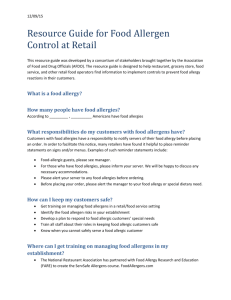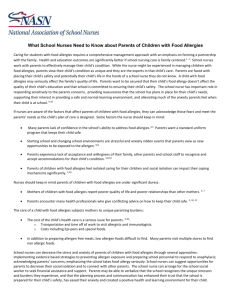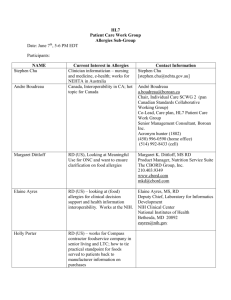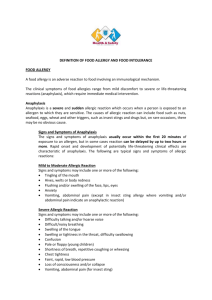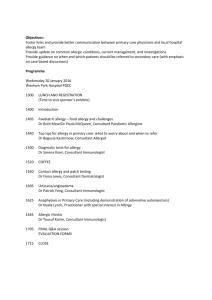HL7 Patient Care Work Group Allergies Sub
advertisement
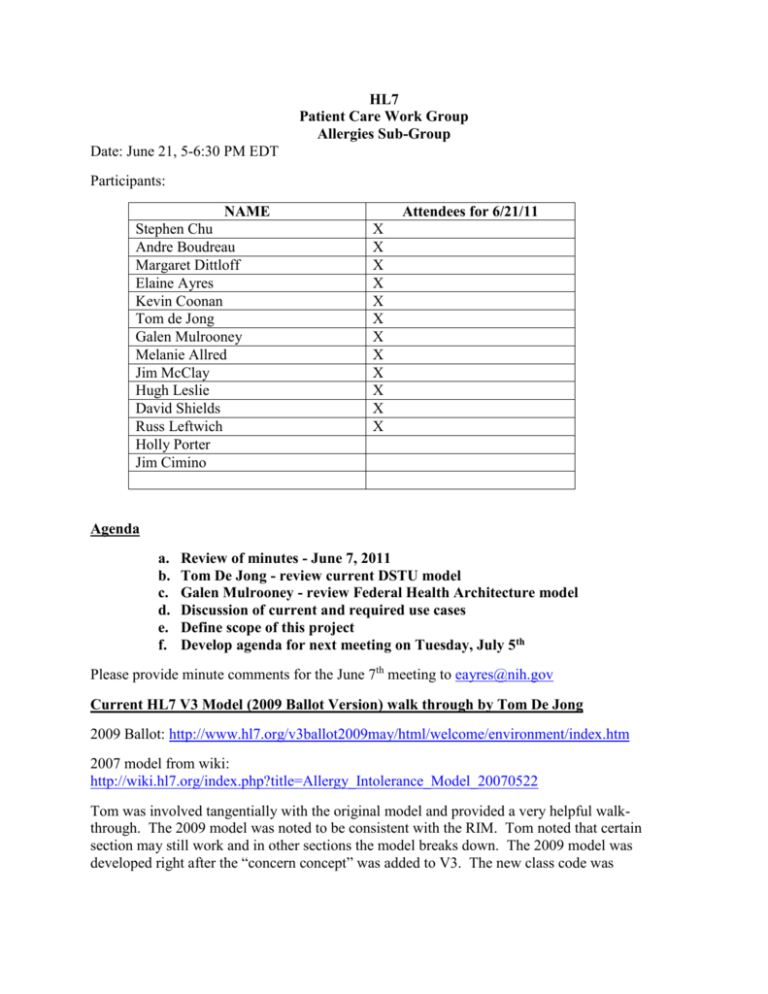
HL7 Patient Care Work Group Allergies Sub-Group Date: June 21, 5-6:30 PM EDT Participants: NAME Stephen Chu Andre Boudreau Margaret Dittloff Elaine Ayres Kevin Coonan Tom de Jong Galen Mulrooney Melanie Allred Jim McClay Hugh Leslie David Shields Russ Leftwich Holly Porter Jim Cimino Attendees for 6/21/11 X X X X X X X X X X X X Agenda a. b. c. d. e. f. Review of minutes - June 7, 2011 Tom De Jong - review current DSTU model Galen Mulrooney - review Federal Health Architecture model Discussion of current and required use cases Define scope of this project Develop agenda for next meeting on Tuesday, July 5th Please provide minute comments for the June 7th meeting to eayres@nih.gov Current HL7 V3 Model (2009 Ballot Version) walk through by Tom De Jong 2009 Ballot: http://www.hl7.org/v3ballot2009may/html/welcome/environment/index.htm 2007 model from wiki: http://wiki.hl7.org/index.php?title=Allergy_Intolerance_Model_20070522 Tom was involved tangentially with the original model and provided a very helpful walkthrough. The 2009 model was noted to be consistent with the RIM. Tom noted that certain section may still work and in other sections the model breaks down. The 2009 model was developed right after the “concern concept” was added to V3. The new class code was “AllergyIntoleranceConcern” and specifies the assessment of the existence of an allergy or intolerance based on a reaction (or an assumed adverse reaction). A concern class is an empty shell (or grouper) that links acts that are part of the same concern about a patient’s health. The patient presents with a problem or complaint. That is the first observation that is linked to a concern. Discussions following the presentation of the HL7 Model: Allergy Observations – what is causing the reaction, not the reaction itself. Don’t mix allergy reaction with the propensity for the reaction. The word observation is confusing. Need a special class of observation entitled “assessment”. This should distinguish from a patient reported reaction versus a reaction observed by the clinician. There was a discussion as to whether these two variants should be the same or different class codes e.g. tested or observed versus reported by patient or doctor. The act class would be patient or physician. Reaction Observations - is also an observation. This appears to have changed in the various models. A reaction needs to be separated from reaction observations or what is called the reaction “assessment” . Relationship between “Reaction” Class and “SubstanceAdmin” Class General feeling of “StartAfterStartOf” ActRelationship only asserts a weak temporal relationship. The model needs a stronger “causal” relationship type however, it is often difficult to assert that causal relationship. The trigger model of “exposure” class needs “causal” vocabulary for ActRelationship and should substantiate the one to many observations of reactions that may occur after a substance administration. Exposure class The exposure class was created after this model was created. Was in the RIM and then taken out. SubstanceAdmin (such as with medication administration or materials) implies intent versus exposure. Other items to consider for the exposure: Accidental ingestion (for example by a child) Unintentional ingestion Environmental exposure Note - May want to the option to state an allergy without a link to a reaction or substance admin. In Model the Blue box connecting AllergyIntoleranceObservation and Agent should be causative agent instead of participant. Severity of Reaction - Severity a useful (or not useful) concept to qualify “Allergy”. There were significant debates over this question/issue. Strong views were expressed that “severity” is applicable to reaction signs/symptoms but the severity assessment has little clinical utility when applied to “allergy”. There are objective validated scaling instruments that can be used like CTCAE or an apache score. However, these rely on other data points. A “severe allergy” – is subjective, and context based. Noted issues with scales are that they can mix outcome and severity, and they are subjective. Note – most clinicians do not know these scales and rely on the reaction observed at the time. The severity itself may be different from instance to instance. This discussion should continue off-line (by email exchanges). Food allergies – not noted as a substance administration – would be a “material. Discussion: Could potentially fit in either category. Material linked to a kind – may be a personal reaction. Note that food ingestion is an intentional act so may well fit as substance administration. Another use case for using either substance administration or material would be a vaccine. To upgrade model – will need to look at common product model – can specify kind and instance. VA Data model – Galen Mulrooney The FHIM model can be viewed at www.fhims.org FHIM (Federal Health Information Model) a group of logical models to be used by the US Federal Government. This enterprise architecture is a part of the FHA (Federal Health Architecture). Various US federal agencies have participated in the development of these models by contributing their enterprise architecture models. DOD, VA, FDA, CDC, IHS and CMS are the most active. The VA model formed the basis of the FHIM, and the BRIDG from NCI, the Structured Product Model from FDA, the RCRIM, and CDC Public Health Model were also integrated.. Purpose: The focus is on the maintenance of a list of conditions which may be a contraindication to actions contemplated by clinicians (i.e., drug-allergy interactions contraindicate prescribing certain drugs; food allergies contraindicate certain diets). A secondary focus is the characteristics of data exchanged between EHR systems. Therefore we emphasized the list aspects of “Allergy List” rather than delving into the intricacies of Allergy/Intolerance. Likely that would be a separate model that goes into the clinical aspects more deeply, and the two would be linked somehow. Adopters are able to produce HL7 artifacts from the model like a CDA. This model is like a DAM and includes the logical structure of each domain. Note attributes marked with “code”. The “Code” is a fake data type and a script can replace “code” of choice from V2 or V3. Terminologists can select appropriate codes of choice. Note – “act to act” have no act relationships (or default). Users have found that act relationships do not add value to the logical model. However, users can generate an act relationship on the fly with a script if needed. When a list of allergies is sent from one system to another – what are the allergies they have? Model must include foods not just drugs. Food allergies must be expressed so the CDS supports the dietitians. Top class is the intolerance list and from a clinical perspective “allergy” and “intolerance” are siblings. Note the properties of the allergies, rather the source itself. Lists will come from many different sources. One entry might be NKA. Other lists may have actual items. The model includes both reported reactions and observed reactions. Reactant code and category is a part of the model. The model has six categories of allergies – because each points to a different source list. Ex – food points to UNII codes. Food product allergies and environmental allergies point to SNOMED. Attached are two diagrams: the current model, and an earlier version that contained separate subclasses for each kind of allergy/intolerance (Originally, I had subclasses for each kind of allergy, because the coding systems used for each type are different, but the terminologists suggested that this can be handled in terminology and therefore we collapsed the subclasses back into the super class). Fhim_Allergies_Di Fhim_Allergies_Di agram_20110329.docx agram_20110609.docx Terminologists noted that it is hard to differentiate kinds of allergies. Caffeine is in food but is also in drugs. Is this a food allergy or medication allergy? Therefore, they created value set with all food and drugs referenced as “reactant”. The user would select type of reactant. Example - noted allergic reaction after eating shrimp. Is it a reaction to shrimp or to shellfish (e.g. the entire class)? This class issue comes up with drugs as well. Are you allergic to one instance in the class or the entire class? And, this may change over time. The model also has a state change – active, inactive, reactivate, obsolete. Do not want to delete an allergy record – retain all records. Intolerance condition versus health concern. Modelled separately, but an intolerance is a type of health concern. It is a tool for contraindications. Additional Discussion Allergies are a hot topic in Canada. The term used is “Propensity for Reaction” and the Canadian model differentiates between allergy and intolerance. With HL7 current models it is hard to differentiate between intolerance and an allergy. However, these are two distinct concepts. In the Netherlands, allergy and intolerance are sibling concepts. Also use the term hypersensitivity. This implies a specific reaction. The definition of Intolerance is non-allergic reaction (no source noted) Clinician assessment of allergies – not clear if it type 1 or type 2. It is important but usually not known. Do we need two separate models - an adverse reaction that is unknown, vs. actual skin tests with immunoassays? Galen will try to engage additional clinician participants from the FHIM calls. In the AU model uses adverse reactions for allergies and intolerance. BRIDG models the adverse event as well. In Canada – collect definitions of concepts and Andre will provide these. We need a good solid clinical base and it is important to align the general practitioners with the allergists. Allergy Mailing List - The decision was to keep all communication on the Patient Care list, as well as other groups to date. AGENDA for July 5 Review and approve minutes from June 7 and June 21 meetings. VA model - revisit with Galen Mulrooney. AU model – Hugh Leslie. Canadian model – Andre Boudreau – July 19th. Project plan and project scope statement. Plan agenda for July 19 conference call.



